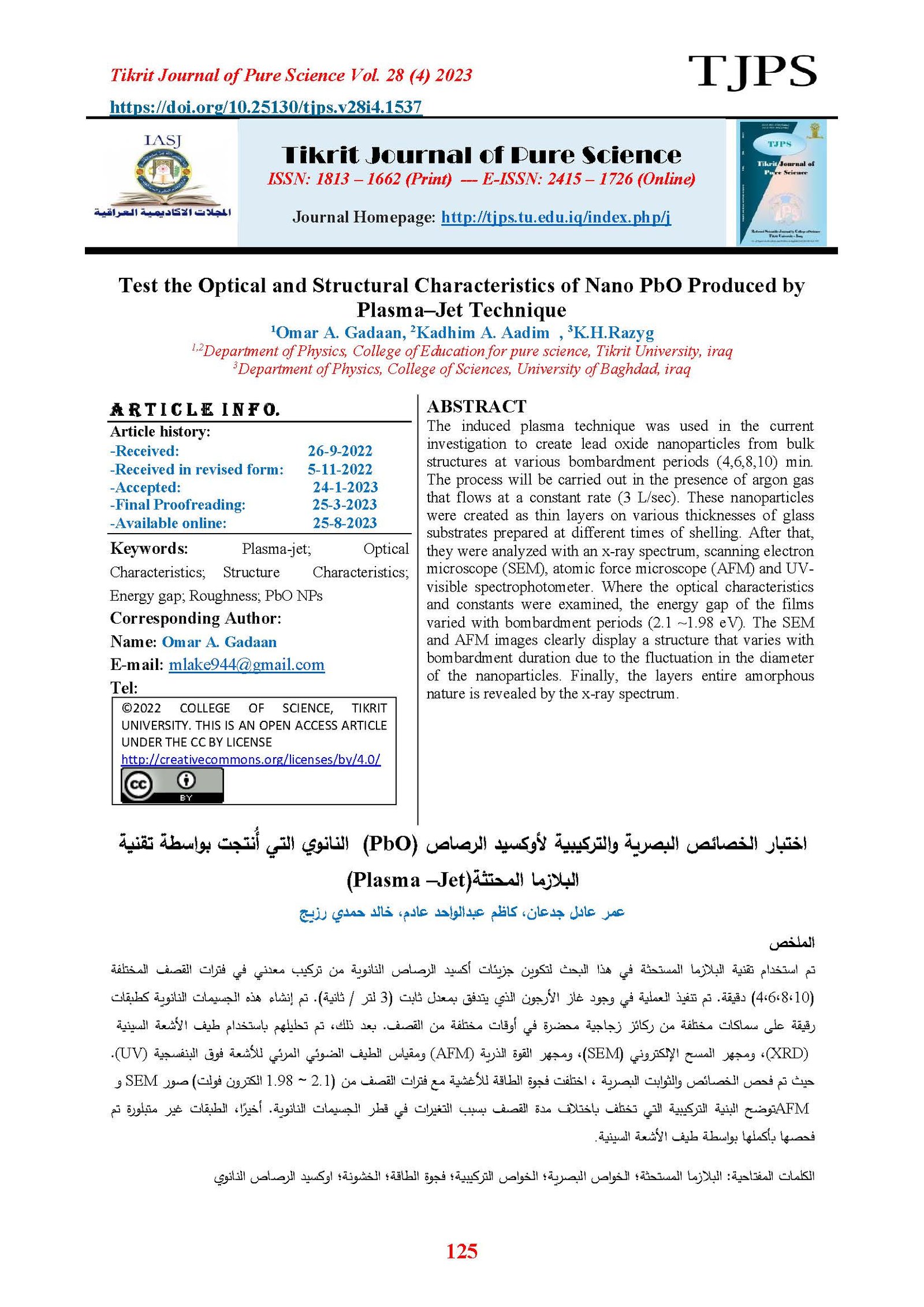Test the Optical and Structural Characteristics of Nano PbO Produced by Plasma–jet Technique
Main Article Content
Abstract
The induced plasma technique was used in the current investigation to create lead oxide nanoparticles from bulk structures at various bombardment periods (4,6,8,10) min. The process will be carried out in the presence of argon gas that flows at a constant rate (3 L/sec). These nanoparticles were created as thin layers on various thicknesses of glass substrates prepared at different times of shelling”. After that, they were analyzed with an x-ray spectrum, scanning electron microscope (SEM), atomic force microscope (AFM) and UV-visible spectrophotometer. Where the optical characteristics and constants were examined, the energy gap of the films varied with bombardment periods from 2.1 ~1.98eV. The SEM and AFM images clearly display a structure that varies with bombardment duration due to the fluctuation in the diameter of the nanoparticles. Finally, the layers' entire amorphous nature is revealed by the x-ray spectrum.
Article Details

This work is licensed under a Creative Commons Attribution 4.0 International License.
Tikrit Journal of Pure Science is licensed under the Creative Commons Attribution 4.0 International License, which allows users to copy, create extracts, abstracts, and new works from the article, alter and revise the article, and make commercial use of the article (including reuse and/or resale of the article by commercial entities), provided the user gives appropriate credit (with a link to the formal publication through the relevant DOI), provides a link to the license, indicates if changes were made, and the licensor is not represented as endorsing the use made of the work. The authors hold the copyright for their published work on the Tikrit J. Pure Sci. website, while Tikrit J. Pure Sci. is responsible for appreciate citation of their work, which is released under CC-BY-4.0, enabling the unrestricted use, distribution, and reproduction of an article in any medium, provided that the original work is properly cited.
References
[1] N. Braithwaite. (2000). Introduction to gas discharges. Plasma Sources Sci. Technol, 9:517–527.
[2] J. Diedrich. (2007). Laser-Induced Breakdown Spectroscopy on Bacterial Samples. M.Sc. thesis, Wayne State University USA.
[3] A. Dinklage, T., Klinger, G., Marx, L. and Schweikhard. (2005). Plasma physics confinement transport and collective effects. Lect. Notes in phys. 670, Springer, Berlin Heidelberg, Chap. 1.
[4] Bratovcic A. (2019). Different applications of nanomaterials and their impact on tehenvironment. SSRG International Journal of Material Science and ingineering, 5:7.
[5] Greenwood, N.N. and Earnshaw, A. (1998). Chemistry of teh Elements. 2nd Edition, Butterworth-Heinemann, Oxford.
[6] Michele-AugustoRIVA; Alessandra LAFRANCONI; Marco-Italo D'ORSO; Giancarlo CESANA. Safety and Health at Work ; 11-16, 2012. Artigo em Inglês | WPRIM | ID: wpr-21396, Biblioteca responsável: WPRO
[7] Rich, V. (1994)،،، The International Lead Trade،،، Woodhead Publishing،،، ISBN 978-0-85709-994-5, Archived from the original on 04 July 2019.
[8] Winder, C. (1993b)،،، "The history of lead — Part 3"،،، LEAD Action News،،، 2(3)،،،
ISSN 1324-6011 2016 Archived from the original on August 31, 2007. Retrieved February 12, 2007.
[9] Fiorini, E. (2010). 2.000 years-old Roman Lead for physics. Aspera European Astroparticle network ، 016 7–8. Archived from the original (PDF) on 26 April 2018. Retrieved 29 October 2016.
[10] Michael, B. (2004). Allgemeine und anorganische Chemie. Spektrum, Heidelberg, ISBN, 3-8274-0208-5.
[11] Anderson, J. (1869). Malleability and ductility of metal. Scientific American, 21(22): 341–43.
[12] , R. H. AL-Saqa I. K. Jassim. (2022). Effect of substrate temperature on the optical and structural properties of CaZnO3 perovskite thin films. Journal of Nanomaterials & Biostructures. Digest Journal of Nanomaterials and Biostructures, 18(1):165 – 172.
[13] Margarita, I., Victoria, I., Vorobyova and Iryna, V. (2020). Preparation of Silver Nanoparticles in a Plasma-Liquid System in the Presence of PVA: Antimicrobial, Catalytic, and Sensing Properties, Volume 2020 | Article ID 5380950 | https://doi.org/10.1155/2020/5380950.
[14] Aviraj, I., Mandeep, S., Sherif, A.T., Billy, J.M., Edwin, L.H.M., Michelle, J.S., Rajesh, R. and Vipul, B. (2022). Reactive Oxygen Species Sequestration Induced Synthesis of β-PbO and Its Polymorphic Transformation to α-PbO at Atomically Thin Regimes. ACS Nano, 16 (7), 10679-10691. DOI: 10.1021/acsnano.2c02432
[15] Smith, C.W., Narendra, K.S., and Gevelber, M.A., (1995). Modelling for Control of Induction Plasma Deposition. Chemical Engineering Science, 50(23): 3747-3761.
[16] R.H. AL-Saqa and I.K. Jassim. (2022). Effect of substrate temperature on the optical and structural properties of CaZnO3 perovskite thin films. Journal of Nanomaterials & Biostructures, 18(1):165- 172.
